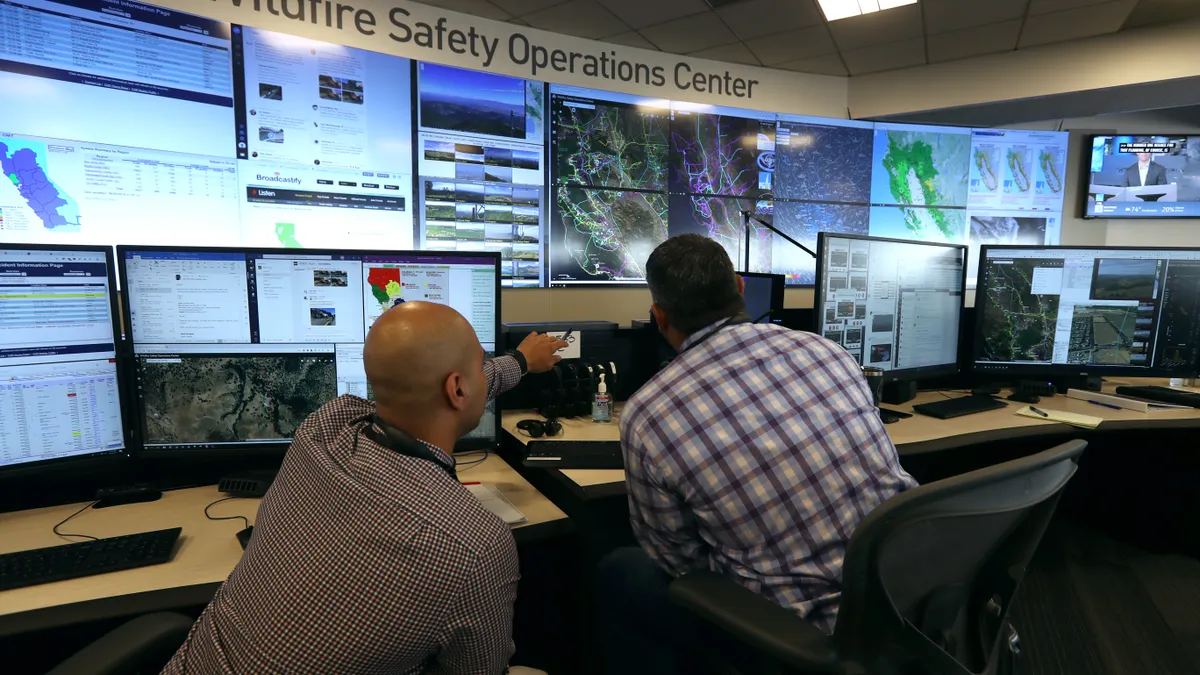Dive Brief:
- California regulators on Thursday voted to place Pacific Gas & Electric (PG&E) in a six-step enhanced oversight and enforcement process which could open up the possibility down the line of revoking the utility's operational certificate, after identifying problems in its wildfire prevention work in 2020.
- At the same time, the California Public Utilities Commission (CPUC) scrapped another proposal ratifying a safety certification granted to PG&E in January, allowing a previous certification to stand. The move has drawn protests from ratepayer advocates, who say that refusing to vote on the draft resolution blocks their ability to appeal it in the courts.
- Both actions come as the CPUC's Public Advocates Office (Cal Advocates) pushes regulators to reject the utility's 2021 wildfire mitigation plan, saying in a filing last month that "it does not sufficiently address failures in management oversight, prioritization, recordkeeping, and other issues that contributed to the utility's poor performance in 2020."
Dive Insight:
The CPUC adopted the six-step oversight process for PG&E as a condition of its exit from bankruptcy last year. The steps include additional reporting requirements for the utility and, as a final measure, reviewing and possibly revoking its ability to operate as a utility in California.
The commission opted to initiate this process after its wildfire safety division issued an audit report identifying gaps in the utility's work to remove vegetation from around its power lines — according to the CPUC, the utility last year worked on trimming trees around more lower-risk power lines than high-risk ones. PG&E is now required to file a corrective action plan with the commission within 20 days.
The six-step oversight process is just one of the commision's many tools to keep PG&E accountable, CPUC Commissioner Clifford Rechtschaffen said at Thursday's meeting.
"We've never had a process like this for any other utility, and I don't know of any other PUC in the country that has a process like this," he added.
PG&E spokesperson Lynsey Paulo said in an emailed statement that the utility takes the feedback from the wildfire safety division and others seriously.
"[A]s a result, we have already implemented significant improvements to our Enhanced Vegetation Management program and will continue to do so as outlined in our 2021 Wildfire Mitigation Plan," Paulo added.
The CPUC, however, withdrew a separate resolution originally slated for a vote on Thursday, that would have ratified a previous decision from its wildfire safety division granting PG&E an annual safety certification. That certification essentially provides PG&E with a less stringent burden of proof to pass on wildfire-related costs to its ratepayers.
The CPUC's wildfire safety division issued PG&E its safety certificate in January but shortly after, ratepayer group The Utility Reform Network (TURN) requested that the CPUC review and reverse that decision. In February, the commission issued a proposed resolution that would have upholded PG&E's safety certification. However, the day before the vote was scheduled, the CPUC withdrew that resolution, stating in a letter that the ratification is unnecessary since California law does not require the commission to ratify a decision like this from its wildfire safety division.
TURN, however, said that withdrawing the resolution essentially denies customers due process.
"It means that TURN cannot file an appeal in the court, because there is no decision to appeal," TURN Executive Director Mark Toney said at Thursday's meeting.
"Refusing to vote on the draft resolution at the last minute while refusing to identify another process for appealing the safety certification denies ratepayers their constitutional right to go to court to seek review of an administrative decision," Toney added.
The commission's public advocates office, meanwhile, has been raising concerns about PG&E's 2021 wildfire mitigation plan, which is currently before the CPUC's wildfire safety division. In comments filed with the commission last month, the office pointed to the prioritization issues with PG&E's vegetation management work in 2020, as well as "persistent problems" managing its contractors.
The office is particularly concerned that PG&E has not properly prioritized its vegetation management and grid hardening work in high-risk areas, according to Cal Advocates' Nathaniel Skinner, and instead focused on easier regions to "check the box."
In addition, the advocates' office wants regulators to look into worker injuries tied to wildfire prevention work. In 2020, PG&E recorded one fatality and 95 injuries, 72 of which were contractor injuries associated with vegetation management, the group said in its comments.
Responding to these concerns in a filing earlier this week, PG&E contended that the advocates' office has ignored "the substantial progress, work on wildfire mitigation initiatives, and successes that occurred in 2020." Many of the issues raised by the office have already been or are in the process of being addressed, the utility said.
But the office's concerns persist.
"PG&E is ducking and weaving and dodging and not accepting accountability for the failures of their management in figuring out their vegetation management, their grid hardening, their contractor safety," Skinner said.
PG&E spokesperson Kristi Jourdan said in a statement that the utility also recognized some gaps in 2020, and has offered specific plans for addressing those gaps in 2021.
"Our employees accomplished much for our customers, and we look forward to working with Cal Advocates, the CPUC, Wildfire Safety Division and other stakeholders to continue improving our performance and addressing the state's ever-growing wildfire risk," Jourdan said.















